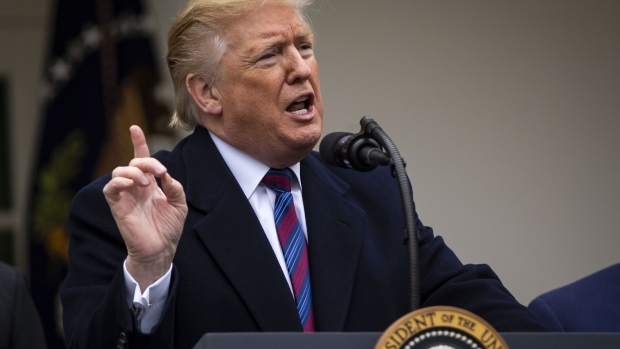Jan 7, 2019
Trump faces pressure from calendar as shutdown stretches on
, Bloomberg News

President Donald Trump says he’s prepared to keep part of the U.S. government shut down for more than a year if necessary to get the money he wants for a wall on the Mexican border.
But a series of deadlines over the next seven weeks will increase pressure on Trump to cut a deal to end a shutdown that could soon become the longest in history. Hundreds of thousands of workers at nine Cabinet departments and other agencies will soon start to miss paychecks, and the longer the standoff continues, the more consequences Trump and Congress will face -- including shuttered courts, filth piling up in National Parks, and delayed tax refunds.
Later in the year, unrelated issues will compound the shutdown’s problems -- the U.S. debt limit will need to be increased, and Congress will have to strike a deal with Trump to prevent steep, automatic cuts in federal spending.
Trump said at a news conference on Friday that “I’m very proud of what I’m doing” and invited reporters to call it “the Schumer or the Pelosi or the Trump shutdown,” referring to Senate Minority Leader Chuck Schumer and Nancy Pelosi, the new House speaker.
“Doesn’t make any difference to me. Just words,” he said.
Vice President Mike Pence and other administration officials met Saturday and Sunday with senior Congressional aides, producing no breakthroughs as Democrats and Republicans remained far apart in their demands. No further meetings of the group are scheduled.
Here are some key upcoming dates and why they could shorten the shutdown:
Jan. 11: Missed Paychecks
For about 800,000 federal workers on furlough or working without pay, this is the date they’ll miss their first paycheck. That milestone will significantly escalate the political pain of the shutdown. While federal workers are not allowed to strike, many can be expected to eventually walk off the job and go work elsewhere -- a challenge for maintaining services like the TSA -- essential for air travel.
Jan. 12: Record Shutdown
The longest shutdown on record was in 1995. The government was closed for 21 days because President Bill Clinton and congressional Republicans, in charge of both chambers for the first time in more than 40 years, couldn’t agree on a spending plan.
Jan. 21: Davos Man
President Trump is scheduled to travel to Davos, Switzerland, to address global political and business leaders at the World Economic Forum, and he may have to do so while the self-styled deal-maker can’t get his own government re-opened.
Jan. 29: State of the Union
Trump will give his second State of the Union address in the House chamber -- with Pelosi sitting behind him. The backdrop of a government shutdown would cast a pall on what is usually a highlight of the year for any president.
“He doesn’t like getting upstaged,” said Doug Holtz-Eakin, president of the American Action Forum and former director of the Congressional Budget Office. He thinks this date is the first important milestone for the president.
Late January and February: Tax Returns
If history is any guide, taxpayers could see their refunds from the Internal Revenue Service held hostage if the shutdown extends into the filing season, which begins soon. In previous shutdown contingency plans, the IRS would accept tax returns, but would be prohibited from issuing refunds, which averaged about $2,899 per check in 2018.
The agency has yet to release an updated version of its shutdown plan during a filing season, but will likely do so in the coming days.
Holtz-Eakin said there should be considerable overlap between Trump’s voter base and the kind of Americans who seek -- and need -- early tax refunds. “That’s why it matters so much,” he said.
March 1: Debt Limit
The current suspension of the U.S. debt limit expires. With extraordinary measures, the U.S. government could likely continue normal operations into the summer. Still, March 1 becomes another pressure point for the impasse to be resolved, and the longer a shutdown continues, the more likely other budget items -- like a deal to prevent automatic spending cuts in 2020 -- get wrapped into the talks.
All Year: Census
The Census Bureau is shuttered, preventing work on the decennial count of every American -- data crucial to allocate federal spending and redraw congressional districts. A shutdown hurts the Trump administration’s ability to conduct the Census on its terms.
--With assistance from Laura Davison.








